4D-BIM-Based Workspace Planning for Temporary Safety Facilities in Construction SMEs
Abstract
:1. Introduction
2. Literature Review
2.1. Importance of Causality Analysis of Construction Fatality
2.2. TSFs in Construction SMEs
2.3. Bim-Based Safety Planning
2.4. Need for an Effective Workspace Planning for TSFs Based on 4D BIM Platform
3. A Comprehensive Framework for Proposed System
- Hazard investigation module. This module consists of the following two-stage process: data input process and allocating safety contents process. The input data process is a preparation of project 3D model and 2D data such as project schedule and the Fatal Four data collected from the OSHA website. Following this, the allocating safety contents is a procedure of analyzed and assessed Fatal Four data. Concurrently, the designated tools for 2D and 3D data exchange such as a graphical algorithm and BIM were employed for developing the linking of databases for the next module.
- Hazard Elimination module. The safety performance process was developed by 4D-based safety information modeling (4D-SIM). Relevant safety contents consist of safety regulations and prioritized TSFs are displayed in the visual environment, in which serious hazard notifications and model-linked TSFs automatically shown by construction sequences. The accessible approach was adopted by uploading 4D-SIM data on the company’s server using the BIM cloud. Finally, it can be seen from the beige box in the last process, 4D-SIM data can be integrated with augmented reality (AR) for the purposes of safety monitoring at construction site. In this practical application step, the required TSFs for specific activities were uploaded and inquired from BIM cloud server. Then, the users can approach the WPT application everywhere by accessible devices such as a tablet, mobile phone, monitor, etc. The AR can connect to these devices for supervision purposes. The integration of BIM and AR creates a visual interaction for users to read and update safety facilities information to facilitate AR part for monitoring the installation and removal of TSFs in real site construction. More details of this collaboration process will be developed and clarified in further study.
4. Data Assessment Process
4.1. Fatality Data Collection
4.2. Theoretical Analysis of Fatal-Four-Related Hazards
- Fatal Four Ratio: From OSHA data reports, the percentage of fatality cases corresponding to each Fatal-four type (i.e., falls, struck by, electrocutions, and caught-in between) is determined for each construction activity.
- Essential Hazards Assessment: The essential hazard is a type of Fatal Four that has high possibility to happen. It is determined by Fatal Four type that has highest percentage from the Fatal Four ratio.
4.3. Database Assessment System Implementation
5. Design for WPT System
5.1. WPT System Development
5.2. Linking Process of Contents in WPT System
5.3. Logic of TSF System Development
6. Case Study for Automatic Installing TSF System in a Residential Building
6.1. Case Scenario
6.2. Automated Linking of the Excel Data to the BIM
- Retrieving all wall elements including external and internal walls in the Revit model.
- Retrieving all external walls. In Dynamo and Revit API term, each type of wall has a different function: the external wall function is 1 and the internal wall function is 0. Based on this, the “List.FilterByBoolMask” node was used to filter and capture all external walls in the model.
- For each external wall, the next node obtains the constraint-based of walls, which is wall elevations.
- At the same time, Dynamo processes all data from the Excel file consist of the planned date of constructing each wall elevation and creates the “dictionary” in the visual program environment. In this case, a dictionary is a data type composed of a collection of the key-value pairs, instead of an index value like in a list. Dictionary has no ordering of data and the user can look up data using a key instead of an index value, as in a list. In particular, the dictionary has elevation as the “Key” and the corresponding date for constructing the external walls at this elevation is the “Value”.
- Accordingly, Dynamo will obtain the Value (the corresponding date for building each wall) at the specified Key (the wall elevation). The “Element.SetParameterByName” will automatically add the information (masonry work date) to all external walls.
6.3. Simulation of TSF System with Arbitrary Constructing Time
7. WPT System Evaluation
- Understand: How well do the users understand the system? Considering the participant’s ability to understand safety requirements and its implementation through these approaches.
- Feasibility: Is this system capable to be implemented in your company? Representing the usability and applicability of the proposed system in construction SMEs.
- Cost: Do you think this system is costly? Considering the long-term impact on the cost of using this system including labor-cost, rework-cost, and other indirect costs.
- Ease: Is this system easy to use? Considering participants’ senses when using the interactive visualization system and paper-based system. The safety information can be approached easily by flexible access from personal devices.
- Effectiveness: Does this system improve accessibility to safety practices? Considering the performance of the system by addressing required safety contents in a specific time and place through the visual interaction.
- Time: How much time you must spend to make safety planning on this system? Considering spending time in comparison of WPT system and conventional method to develop a safety planning based on participants’ experience.
- Upgradability: Can the system be improved for changes in the market? Focusing on the ability to update and synchronize TSFs information from the changing of supply market and project progress.
8. Discussion
9. Conclusions
Author Contributions
Funding
Conflicts of Interest
References
- Awolusi, I.G.; Marks, E.D. Safety activity analysis framework to evaluate safety performance in construction. J. Constr. Eng. Manag. 2017, 143, 05016022. [Google Scholar] [CrossRef] [Green Version]
- Winge, S.; Albrechtsen, E.; Mostue, B.A. Causal factors and connections in construction accidents. Saf. Sci. 2019, 112, 130–141. [Google Scholar] [CrossRef]
- Pillay, M. Accident causation, prevention and safety management: A review of the state-of-the-art. Procedia Manuf. 2015, 3, 1838–1845. [Google Scholar] [CrossRef] [Green Version]
- OSHA. Commonly Used Statistics. Available online: https://https://www.osha.gov/data/commonstats.html (accessed on 13 May 2019.).
- Arewa, A.; Farrell, P. A review of compliance with health and safety and safety regulations and economic performance in construction SMEs. In Proceedings of the Annual ARCOM Conference, Edinburgh, UK, 3–5 September 2012. [Google Scholar]
- Lu, S.L.; Sexton, M. Key characteristics of small construction firms: A United Kingdom perspective. In Proceedings of the W065 Joint International Symposium: Transformation through Construction, Dubai, UAE, 15–17 November 2008. [Google Scholar]
- Commission, E. EU SMEs Report. Available online: https://ec.europa.eu/docsroom/documents/38365/attachments/2/translations/en/renditions/native (accessed on 13 May 2019).
- SBA. US Small Business Employees. Available online: https://www.sba.gov/sites/default/files/advocacy/United_States.pdf (accessed on 13 May 2019).
- Kheni, N.A.; Gibb, A.G.; Dainty, A.R. Health and safety management within small-and medium-sized enterprises (SMEs) in developing countries: Study of contextual influences. J. Constr. Eng. Manag. 2010, 136, 1104–1115. [Google Scholar] [CrossRef] [Green Version]
- Gopang, M.A.; Nebhwani, M.; Khatri, A.; Marri, H.B. An assessment of occupational health and safety measures and performance of SMEs: An empirical investigation. Saf. Sci. 2017, 93, 127–133. [Google Scholar] [CrossRef]
- Arboleda, C.A.; Abraham, D.M. Fatalities in trenching operations—Analysis using models of accident causation. J. Constr. Eng. Manag. 2004, 130, 273–280. [Google Scholar] [CrossRef]
- Choe, S.; Leite, F. Construction safety planning: Site-specific temporal and spatial information integration. Autom. Constr. 2017, 84, 335–344. [Google Scholar] [CrossRef]
- Rezgui, Y.; Miles, J. Exploring the potential of SME alliances in the construction sector. J. Constr. Eng. Manag. 2010, 136, 558–567. [Google Scholar] [CrossRef]
- Betsis, S.; Kalogirou, M.; Aretoulis, G.; Pertzinidou, M. Work Accidents Correlation Analysis for Construction Projects in Northern Greece 2003–2007: A Retrospective Study. Safety 2019, 5, 33. [Google Scholar] [CrossRef] [Green Version]
- Zhang, S.; Sulankivi, K.; Kiviniemi, M.; Romo, I.; Eastman, C.M.; Teizer, J. BIM-based fall hazard identification and prevention in construction safety planning. Saf. Sci. 2015, 72, 31–45. [Google Scholar] [CrossRef]
- Wong, L.; Wang, Y.; Law, T.; Lo, C.T. Association of root causes in fatal fall-from-height construction accidents in Hong Kong. J. Constr. Eng. Manag. 2016, 142, 04016018. [Google Scholar] [CrossRef]
- Chi, C.F.; Chang, T.C.; Ting, H.I. Accident patterns and prevention measures for fatal occupational falls in the construction industry. Appl. Ergon. 2005, 36, 391–400. [Google Scholar] [CrossRef]
- Yi, K.J.; Langford, D. Scheduling-based risk estimation and safety planning for construction projects. J. Constr. Eng. Manag. 2006, 132, 626–635. [Google Scholar] [CrossRef]
- Memarian, B.; Mitropoulos, P. Accidents in masonry construction: The contribution of production activities to accidents, and the effect on different worker groups. Saf. Sci. 2013, 59, 179–186. [Google Scholar] [CrossRef]
- Kim, K.; Cho, Y.; Zhang, S. Integrating work sequences and temporary structures into safety planning: Automated scaffolding-related safety hazard identification and prevention in BIM. Autom. Constr. 2016, 70, 128–142. [Google Scholar] [CrossRef]
- Kim, K.; Cho, Y.; Kim, K. BIM-driven automated decision support system for safety planning of temporary structures. J. Constr. Eng. Manag. 2018, 144, 04018072. [Google Scholar] [CrossRef]
- Jin, Z.; Gambatese, J. Bim for temporary structures: Development of a revit api plug-in for concrete formwork. In Proceedings of the CSCE Annual Conference Growing with Youth, Laval, QC, Canada, 12–15 June 2019. [Google Scholar]
- Kim, H.; Ahn, H. Temporary facility planning of a construction project using BIM (Building Information Modeling). In Proceedings of the ASCE International Workshop on Computing in Civil Engineering, Miami, FL, USA, 19–22 June 2011; pp. 627–634. [Google Scholar]
- Belayutham, S.; Ibrahim, C.K.I.C. Barriers and strategies for better safety practices: The case of construction SMEs in Malaysia. Constr. Econ. Build. 2019, 19, 331. [Google Scholar] [CrossRef]
- Zhang, S.; Teizer, J.; Lee, J.K.; Eastman, C.M.; Venugopal, M. Building information modeling (BIM) and safety: Automatic safety checking of construction models and schedules. Autom. Constr. 2013, 29, 183–195. [Google Scholar] [CrossRef]
- Park, C.S.; Kim, H.J.; Park, H.T.; Goh, J.H.; Pedro, A. BIM-based idea bank for managing value engineering ideas. Int. J. Proj. Manag. 2017, 35, 699–713. [Google Scholar] [CrossRef]
- Zhang, S.; Teizer, J.; Pradhananga, N.; Eastman, C.M. Workforce location tracking to model, visualize and analyze workspace requirements in building information models for construction safety planning. Autom. Constr. 2015, 60, 74–86. [Google Scholar] [CrossRef]
- Pedro, A.; Pham, H.C.; Kim, J.U.; Park, C. Development and evaluation of context-based assessment system for visualization-enhanced construction safety education. Int. J. Occup. Saf. Ergon. 2019, 1–13. [Google Scholar] [CrossRef]
- Wetzel, E.M.; Thabet, W.Y. A case study towards transferring relevant safety information for facilities maintenance using BIM. J. Inf. Technol. Constr. 2018, 23, 53–74. [Google Scholar]
- Chen, W.; Chen, K.; Cheng, J.C.; Wang, Q.; Gan, V.J. BIM-based framework for automatic scheduling of facility maintenance work orders. Autom. Constr. 2018, 91, 15–30. [Google Scholar] [CrossRef]
- Park, C.S.; Kim, H.J. A framework for construction safety management and visualization system. Autom. Constr. 2013, 33, 95–103. [Google Scholar] [CrossRef]
- Jin, Z.; Gambatese, J.; Liu, D.; Dharmapalan, V. Using 4D BIM to assess construction risks during the design phase. Eng. Constr. Archit. Manag. 2019, 26, 19. [Google Scholar] [CrossRef]
- Khan, N.; Ali, A.K.; Skibniewski, M.J.; Lee, D.Y.; Park, C. Excavation Safety Modeling Approach Using BIM and VPL. Adv. Civ. Eng. 2019. [Google Scholar] [CrossRef] [Green Version]
- Hongling, G.; Yantao, Y.; Weisheng, Z.; Yan, L. BIM and safety rules based automated identification of unsafe design factors in construction. Procedia Eng. 2016, 164, 467–472. [Google Scholar] [CrossRef]
- Feng, C.W.; Lu, S. Using BIM to automate scaffolding planning for risk analysis at construction sites. In Proceedings of the Annual International Symposium on Automation and Robotics in Construction (ISARC), Taipei, Taiwan, 28 June–1 July 2017; Volume 34. [Google Scholar]
- Hossain, M.A.; Abbott, E.L.; Chua, D.K.; Nguyen, T.Q.; Goh, Y.M. Design-for-safety knowledge library for BIM-integrated safety risk reviews. Autom. Constr. 2018, 94, 290–302. [Google Scholar] [CrossRef]
- Collins, R.; Zhang, S.; Kim, K.; Teizer, J. Integration of safety risk factors in BIM for scaffolding construction. In Proceedings of the 2014 International Conference on Computing in Civil and Building Engineering, Orlando, FL, USA, 23–25 June 2014; pp. 307–314. [Google Scholar]
- Wang, J.; Zhang, S.; Teizer, J. Geotechnical and safety protective equipment planning using range point cloud data and rule checking in building information modeling. Autom. Constr. 2015, 49, 250–261. [Google Scholar] [CrossRef]
- Zhang, S.; Boukamp, F.; Teizer, J. Ontology-based semantic modeling of construction safety knowledge: Towards automated safety planning for job hazard analysis (JHA). Autom. Constr. 2015, 52, 29–41. [Google Scholar] [CrossRef]
- Le, P.L.; Dao, T.M.; Chaabane, A. BIM-based framework for temporary facility layout planning in construction site. Constr. Innov. 2019, 19, 3. [Google Scholar] [CrossRef]
- Acar, E.; Kocak, I.; Sey, Y.; Arditi, D. Use of information and communication technologies by small and medium-sized enterprises (SMEs) in building construction. Constr. Manag. Econ. 2005, 23, 713–722. [Google Scholar] [CrossRef]
- Hale, A.; Walker, D.; Walters, N.; Bolt, H. Developing the understanding of underlying causes of construction fatal accidents. Saf. Sci. 2012, 50, 2020–2027. [Google Scholar] [CrossRef]
- Hinze, J.W.; Teizer, J. Visibility-related fatalities related to construction equipment. Saf. Sci. 2011, 49, 709–718. [Google Scholar] [CrossRef]
- OSHA. Commonly Used Statistics. Available online: https://https://www.osha.gov/fatalities.html (accessed on 13 May 2019).
- OSHA. Commonly Used Statistics. Available online: https://www.osha.gov/SLTC/etools/construction/index.html (accessed on 13 May 2019).
- Sheikhkhoshkar, M.; Rahimian, F.P.; Kaveh, M.H.; Hosseini, M.R.; Edwards, D.J. Automated planning of concrete joint layouts with 4D-BIM. Autom. Constr. 2019, 107, 102943. [Google Scholar] [CrossRef]
- Khan, N.; Ali, A.K.; Van-Tien Tran, S.; Lee, D.; Park, C. Visual Language-Aided Construction Fire Safety Planning Approach in Building Information Modeling. Appl. Sci. 2020, 10, 1704. [Google Scholar] [CrossRef] [Green Version]
- Li, J.; Li, N.; Afsari, K.; Peng, J.; Wu, Z.; Cui, H. Integration of Building Information Modeling and Web Service Application Programming Interface for assessing building surroundings in early design stages. Build. Environ. 2019, 153, 91–100. [Google Scholar] [CrossRef]
- Pham, H.C.; Dao, N.N.; Kim, J.U.; Cho, S.; Park, C.S. Energy-Efficient Learning System Using Web-Based Panoramic Virtual Photoreality for Interactive Construction Safety Education. Sustainability 2018, 10, 2262. [Google Scholar] [CrossRef] [Green Version]
- Le, Q.T.; Lee, D.Y.; Park, C.S. A social network system for sharing construction safety and health knowledge. Autom. Constr. 2014, 46, 30–37. [Google Scholar] [CrossRef]
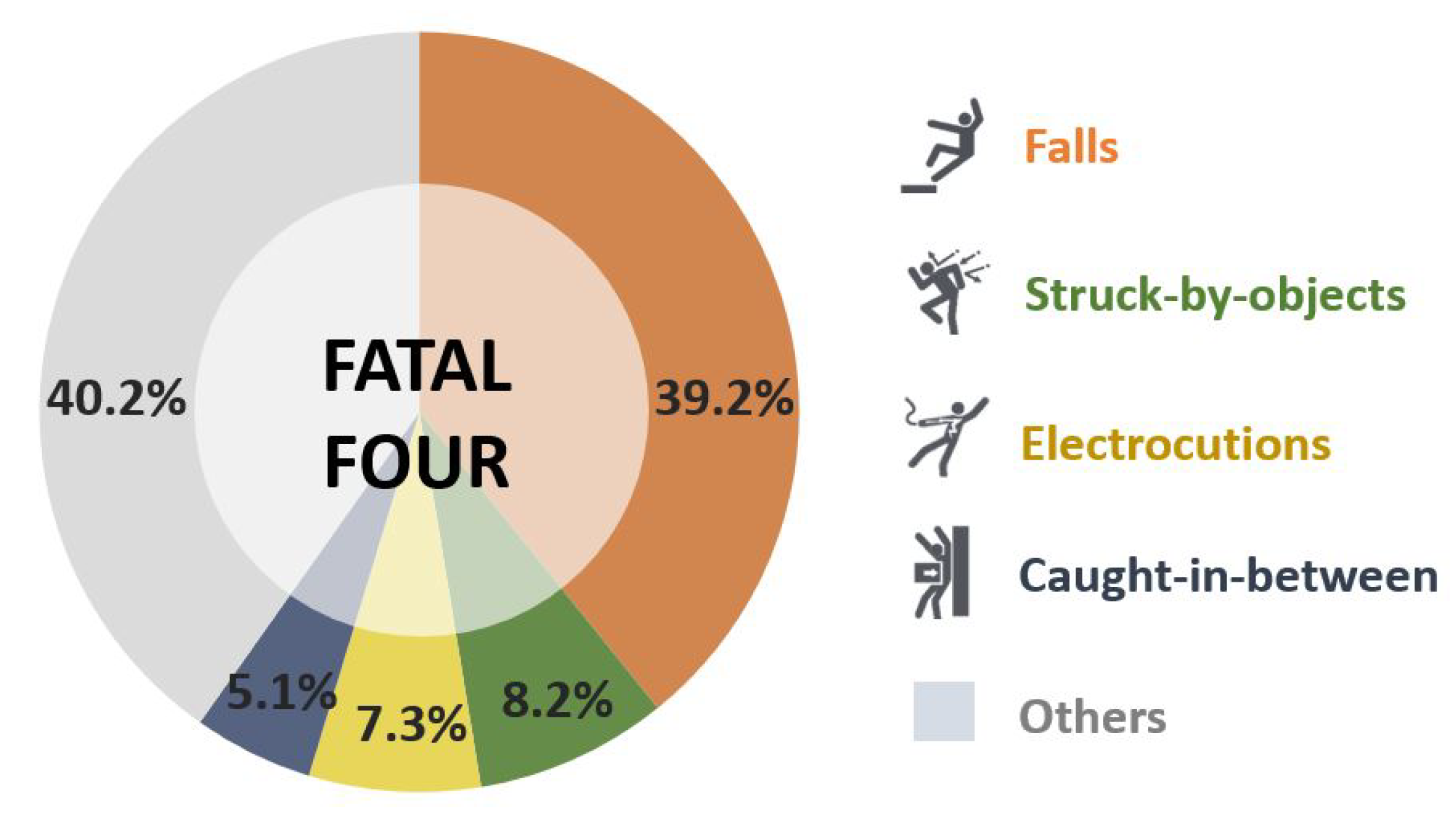
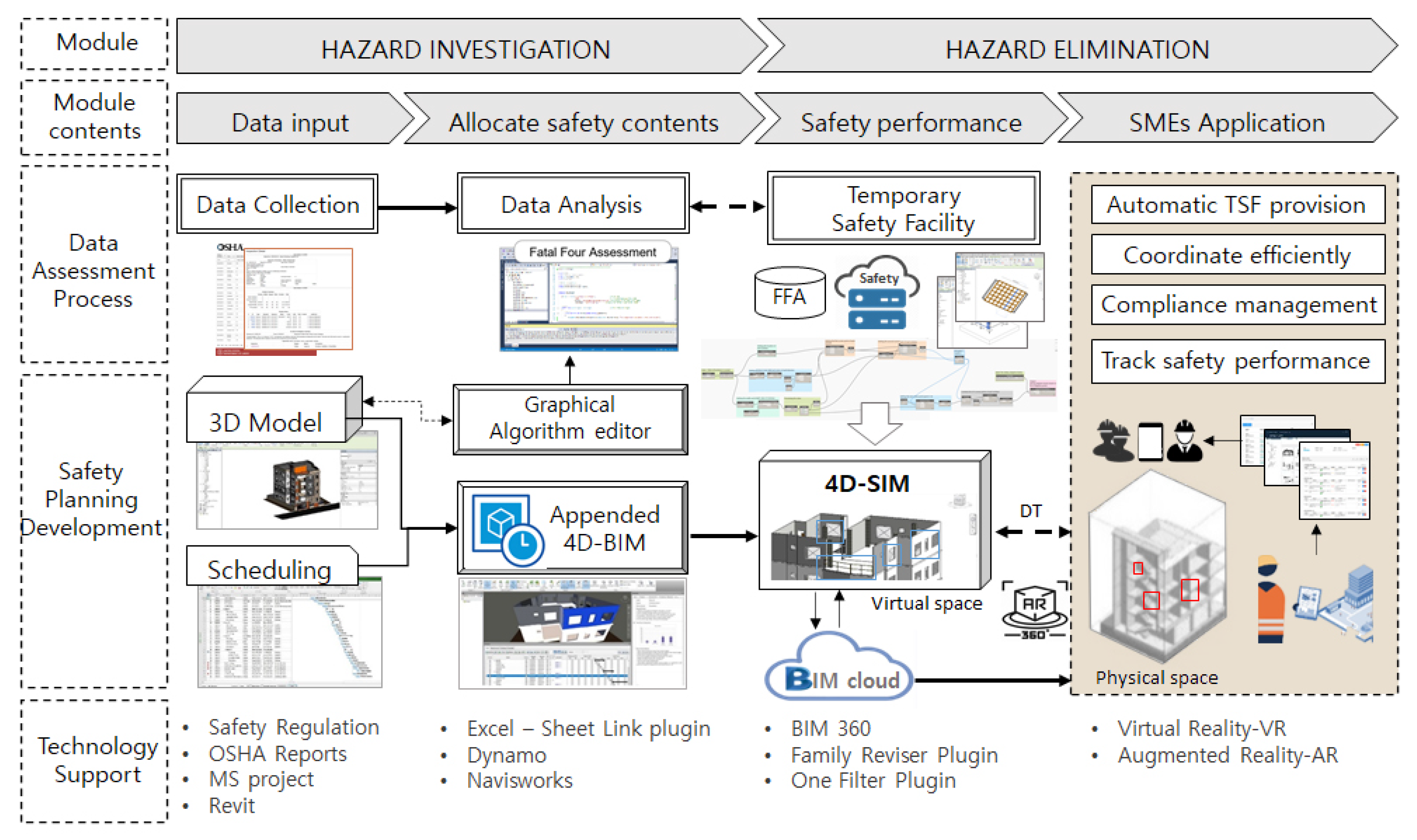


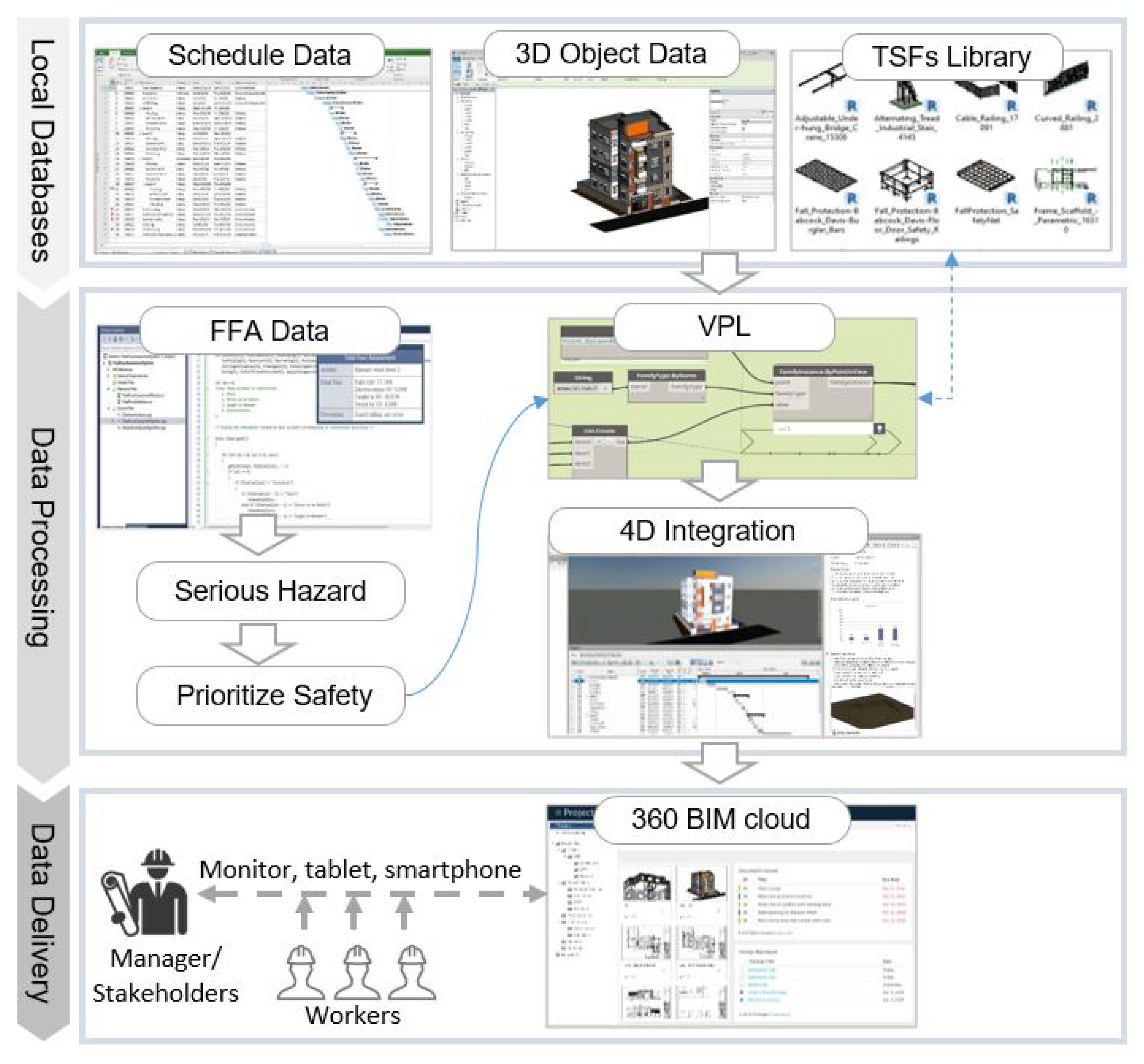
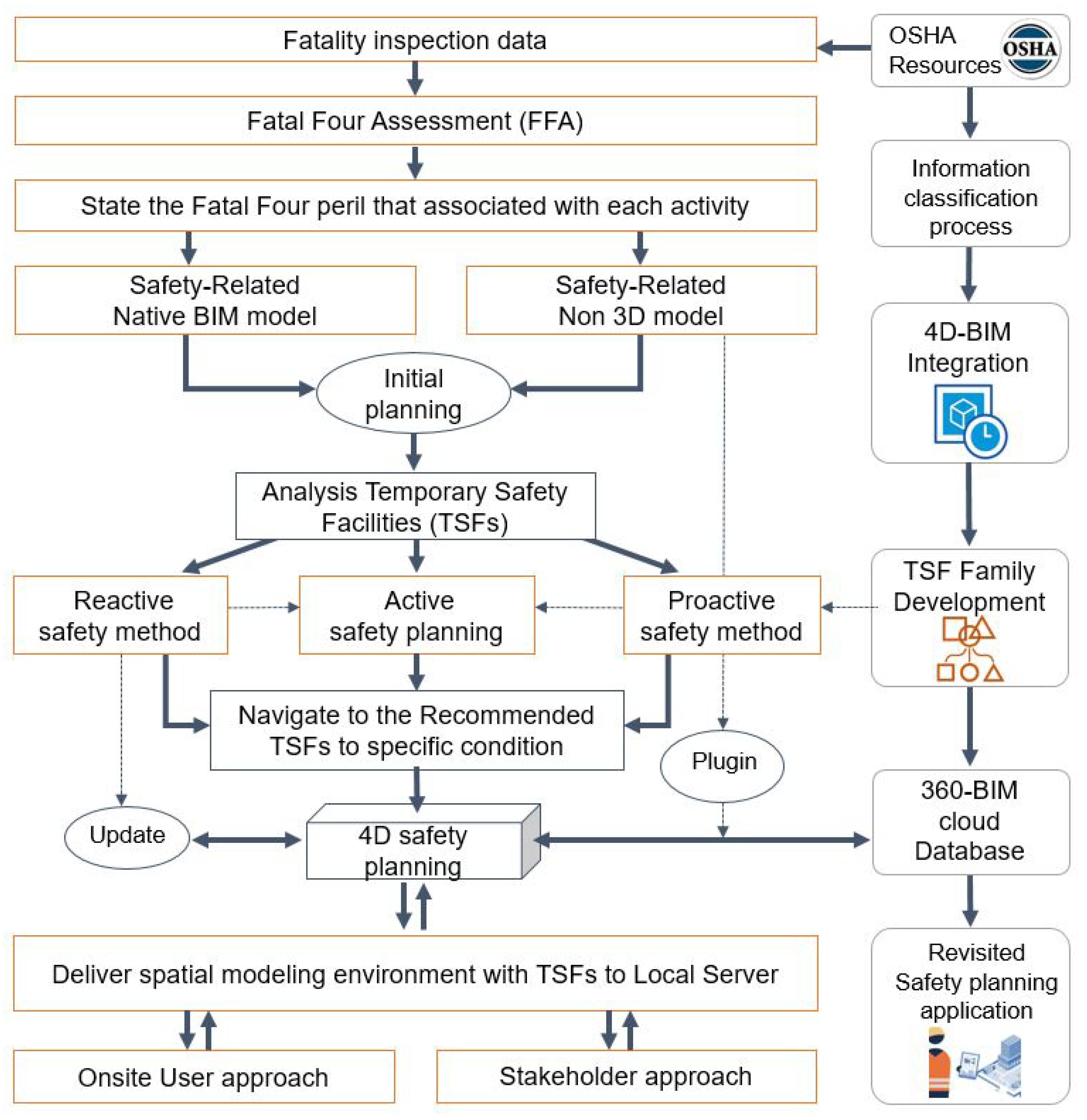

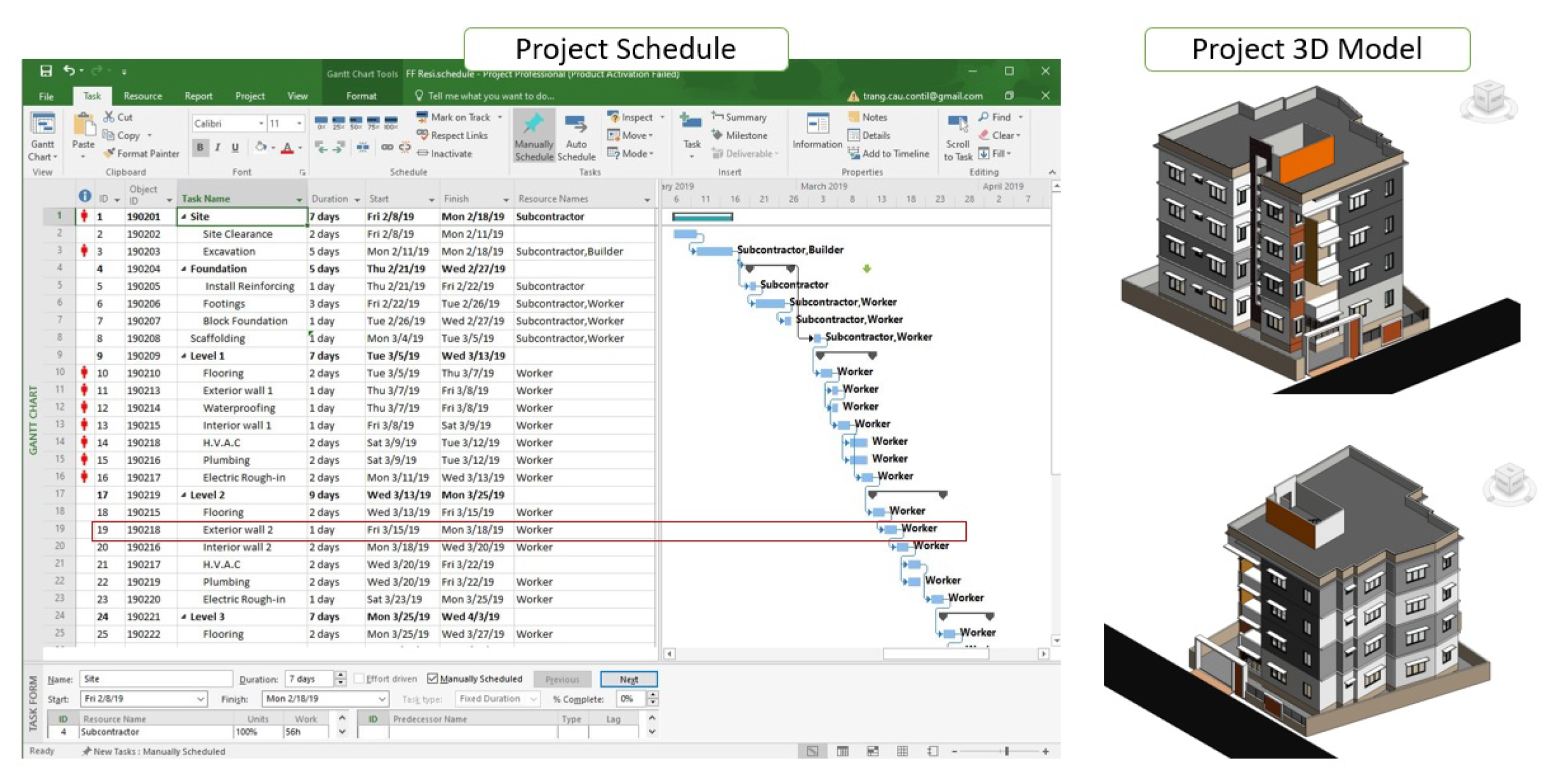

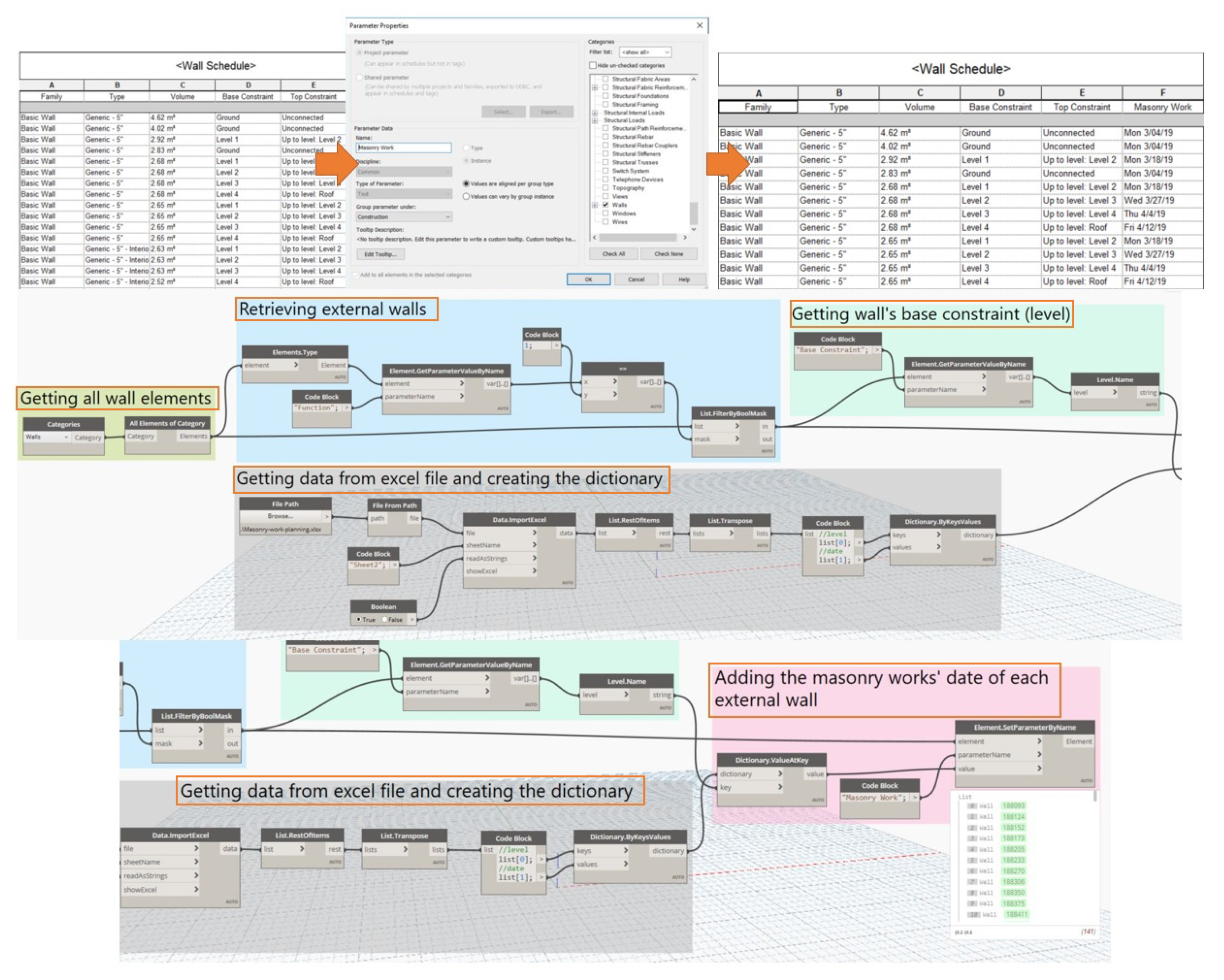
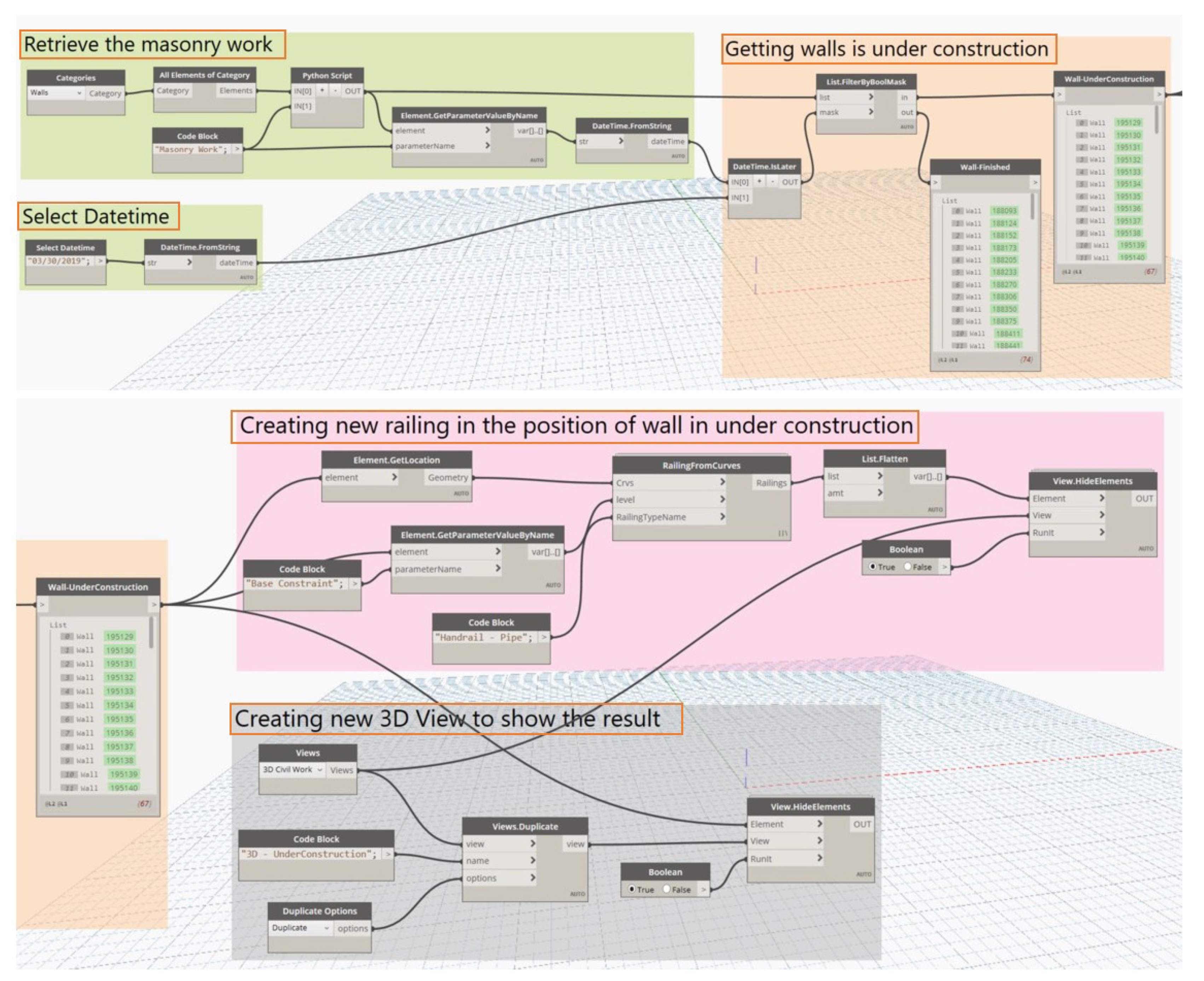
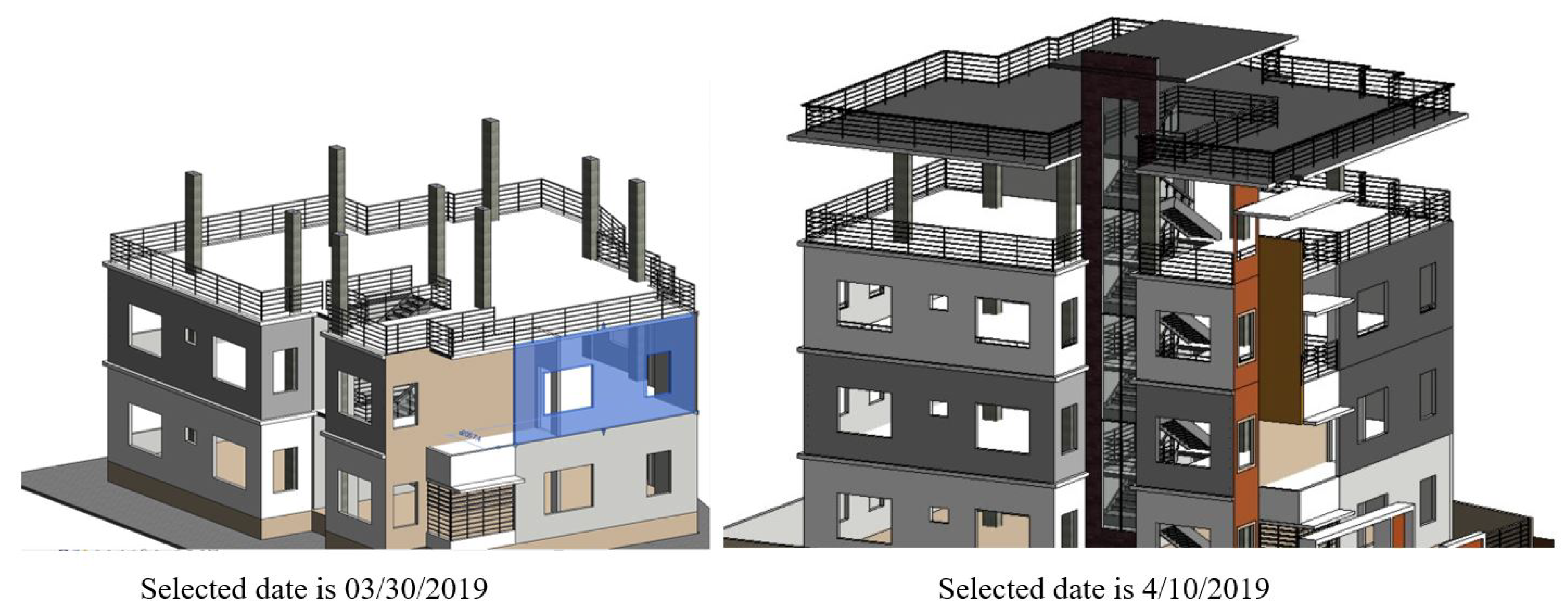

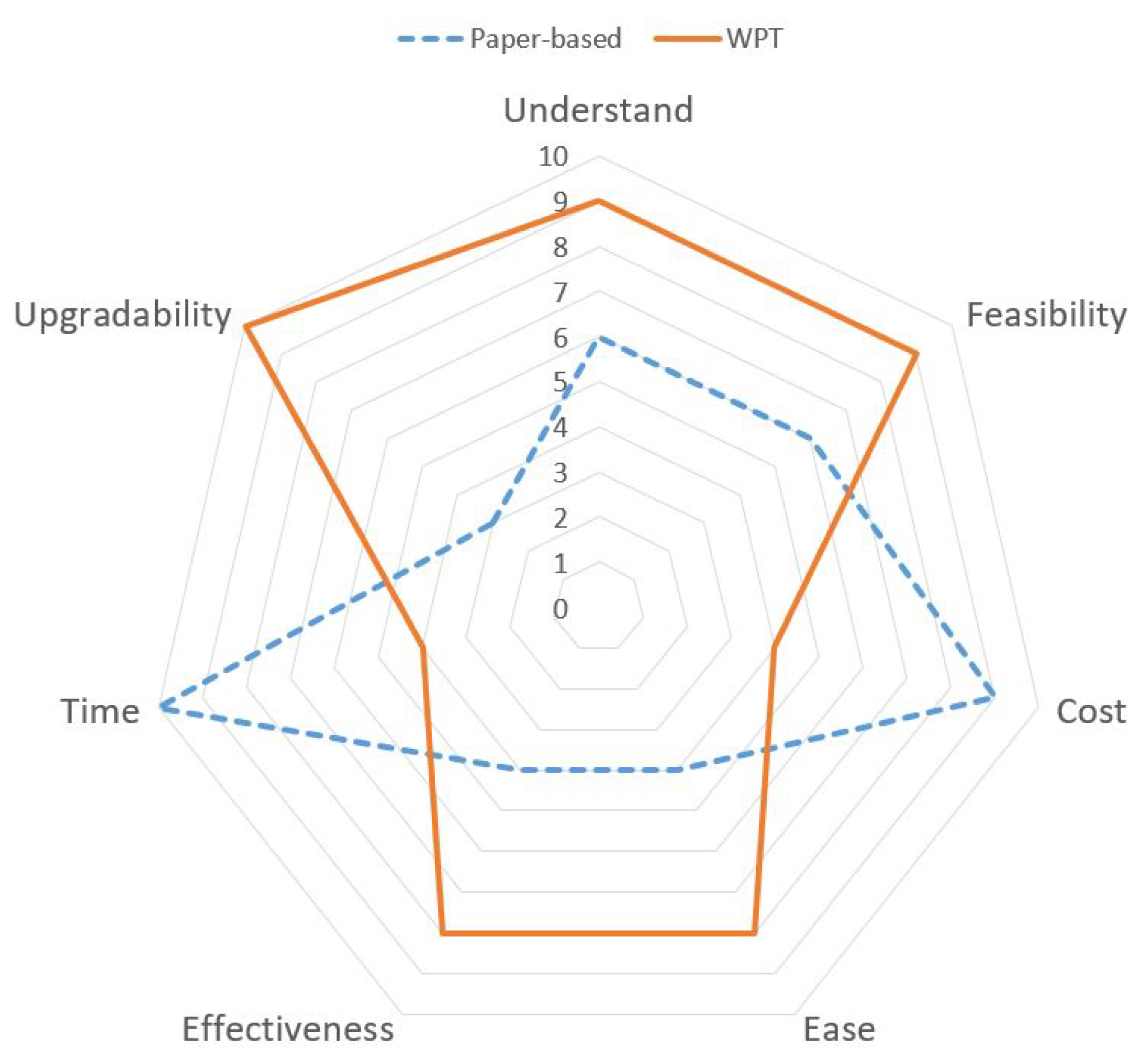
| Ref. | Research Contents | Technology | Hazard | Focus on | Safety Prevention |
|---|---|---|---|---|---|
| [12] | Safety planning process that addresses activity safety from accident data and activity risk factors.Safety analysis was performed by assigning scores to construction occupation type, accident type, and sources of injury. | 4D-BIM | SA | Work zone | N/A. |
| [15] | Fall hazard detection and prevention by automated safety rule-checking algorithms for BIM model. | 4D BIM | SA | Fall hazard | Guardrail. |
| [20] | Address potential safety issues of scaffolding. Automatically identify hazards related to each activity. | BIM | A | Scaffolding work | Scaffolding. |
| [21] | Automated analysis building geometry and safety plans for scaffolding structures considering their costs and duration. | BIM | A | Scaffolding work | Scaffolding, guardrail. |
| [38] | Identifying fall hazards and extracting relevant safety rules related to excavation. | BIM, Point cloud | A | Excavation and trenching | N/A. |
| [27] | Establishing automated workspace visualization using remote sensing and workspace modeling technologies for construction safety planning. | BIM, GPS | A | Workspace conflict | N/A. |
| [39] | Organize, store and re-use construction safety knowledge by ontology. Automated safety planning for Job Hazard Analysis (JHA) using BIM. | BIM, Ontology | A | JHA | Guardrail. |
| [40] | BIM-based framework for multi-objective and dynamic temporary construction site layout design considering cost and adjacency factors. | BIM | N/A | Site layout design | Temporary facility. |
| Safety Contents | Example |
|---|---|
| Accident Date | 20180105 |
| Accident description | Employee Falls From Roof And Is Killed. |
| Accident subject | Open Skylight. |
| Fatal Four Classification | Falls. |
| Work activity | Roof Coatings. |
| Safety regulation | OSHA: 29 CFR 1910.23, 29 CFR 1926.500-503. |
| TSF Recommendation | Temporary construction guardrails or cover, Safety Harnesses. |
| Fatal Four | Hazard Scenarios | Related TSFs |
|---|---|---|
| Falls | Unprotected Sides, Wall Openings, Floor Holes | Guard railing. |
| Improper Scaffold Construction | Scaffold. | |
| Misuse of Portable Ladders | Ladders. | |
| Struck by | Vehicles | Safety Labels. |
| Falling/Flying Objects | Safety net. | |
| Constructing Masonry Walls | Limited zone. | |
| Electrocutions | Contact with Power Lines | Safety Labels, Extinguisher. |
| Path to Ground Missing or Discontinuous | Ground-fault Protection. | |
| Equipment Not Used in Manner Prescribed | Safety Labels. | |
| Improper Use of Extension and Flexible Cord | Safety Labels, Extinguisher. | |
| Caught-in between | No Protective System | Stripping. |
| Unsafe Placement | Marking tape. | |
| Unsafe Access/Egress | Marking tape. |
| Work Level | Wall Height | Protection | Method |
|---|---|---|---|
| Guardrail | Limited Zone | ||
| m | m | No | Yes |
| m | m | Yes | No |
| m Solid | No | Yes | |
| m Opening | Yes | Yes |
© 2020 by the authors. Licensee MDPI, Basel, Switzerland. This article is an open access article distributed under the terms and conditions of the Creative Commons Attribution (CC BY) license (http://creativecommons.org/licenses/by/4.0/).
Share and Cite
Pham, K.-T.; Vu, D.-N.; Hong, P.L.H.; Park, C. 4D-BIM-Based Workspace Planning for Temporary Safety Facilities in Construction SMEs. Int. J. Environ. Res. Public Health 2020, 17, 3403. https://doi.org/10.3390/ijerph17103403
Pham K-T, Vu D-N, Hong PLH, Park C. 4D-BIM-Based Workspace Planning for Temporary Safety Facilities in Construction SMEs. International Journal of Environmental Research and Public Health. 2020; 17(10):3403. https://doi.org/10.3390/ijerph17103403
Chicago/Turabian StylePham, Kieu-Trang, Duc-Nghia Vu, Phuc Le Hieu Hong, and Chansik Park. 2020. "4D-BIM-Based Workspace Planning for Temporary Safety Facilities in Construction SMEs" International Journal of Environmental Research and Public Health 17, no. 10: 3403. https://doi.org/10.3390/ijerph17103403
APA StylePham, K.-T., Vu, D.-N., Hong, P. L. H., & Park, C. (2020). 4D-BIM-Based Workspace Planning for Temporary Safety Facilities in Construction SMEs. International Journal of Environmental Research and Public Health, 17(10), 3403. https://doi.org/10.3390/ijerph17103403






